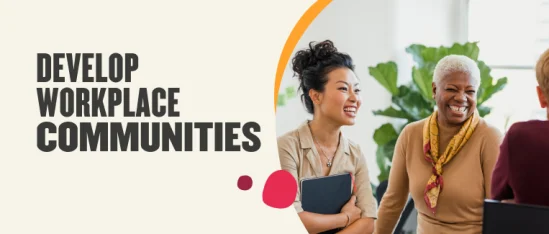This article from guest author, Andra Magerusan, is part of a series of posts on digital HR & the human connection – an exploration of the issues & trends around online HR tools, social media channels, and the desire for a positive culture in the workplace.
What is a workplace?
The workplace concept has changed dramatically over the past decades. While in the past it was common for people to spend their entire lives in one role, leaving after 1- 2 years is much more normal nowadays. It seems as though people have lost their workplace loyalty.
Some would also argue that workplaces have lost their human touch leading to the decrease in employee retention.
What about social media?
Also, the ease with which people can now find out about new roles (or be found via social media) is not helping employers either.
Many businesses have invested in new offices, ping-pong tables, or other side benefits to make their workplace more attractive – but the truly successful ones have invested in understanding, creating and shaping their culture. They sat down and quietly, objectively, took the pulse of their business, one employee at a time.
Leaders learn when they listen
One thing that business leaders find out when listening is that every business has small communities operating within it. A community could be anything from ‘the socialites’ who stay after work for drinks, to a group of mums, or running enthusiasts. These communities are often formed and maintained by psychological factors such as identity, values, needs and connectivity.
Leveraging internal communities
Some thought leaders suggest that there’s an opportunity for businesses to leverage their existing communities to increase employee satisfaction which in turn positively impacts retention.
Along with other essential aspects such as professional & personal development, inspiring managers and a workplace that parallels one’s needs and values, workplace communities could also be a factor positively impacting upon retention.
It’s a subject that requires more investigation in real business environments to truly measure and predict its effects, yet still, good news for employers!
So what defines a community?
Thought leaders in workplace psychology state that a sense of community in the workplace can be achieved through perceptions of similarity to others, identity, willingness to maintain interdependence – and feeling that one is part of a larger structure. Moreover, supervisors and managers play a major role in creating a supportive organisational climate.
The sense of community at work consists of a number of elements:
1. The core element is ‘psychological membership’ or the feeling of belonging to a group that shares some of your values or interests.
2. The second element is influence, where the employee feels they can influence and make a difference in the group and vice-versa and where the membership of such a group enables them to have more workplace influence.
3. Social integration is a fundamentally important aspect of a workplace community. The need to belong is a strong psychological drive. Humans are social creatures and possess a strong intuitive drive to be members of a group and so spend a high amount of effort at creating social bonds. Given we spend a significant amount of time in the workplace considering the psychology of integration should be vital to any organisation.
4. The fourth element is a shared emotional connection that membership of a community enables. Psychologists know the full power of emotions for influencing both decision making and behaviour. We also know that emotional positivity is connected to well-being overall. Emotional connections with people also aid communication and cooperation!
Of course within the workplace environment, these elements might differ in intensity depending on the nature of the community and how invested people are in it.
You nurture communities – you don’t create them
Bob hosted a panel around workplace and communities, called Digital HR & The Human Connection. The panelists (Katharina Wittgens, Marian Bloodworth, Nick Matthews, Phoebe Spinks) unanimously agreed that communities form organically and most importantly cannot be imposed.
The moral of the story here is that you don’t create a community, you nurture it.
Hence, why so many businesses fail when trying to force a desired climate and community on their employees without deploying specialists to understand the existent groups within the workplace.
Some questions business leaders should ask:
- What do your employees actually need and want?
- Are you imposing a culture / community on your staff that doesn’t resonate with them?
- Are your managers giving you the right reading of what the other employees need and want? Or is it more of ‘what they want you to see’?
These are questions that cannot be answered by the yearly employee satisfaction questionnaire or survey.
Recommended For Further Reading
Employees want to look good
At Innovationbubble we have consistently demonstrated (through our client work) that employees do not respond truthfully to these types of measurement systems. Instead they are more motivated to ‘look good’, ‘not bring undue attention upon themselves’, ‘second guess what is being measured’ than they are about providing truthful answers.
As a result, organisations just get inaccurate ‘white noise’ back from such assessments and then wonder why things don’t change despite responding to the ‘staff feedback’. Innovationbubble instead has developed screening engines that measure these non-conscious and hidden influences that impact upon employee engagement and retention.
So how do you do employee satisfaction studies?
Employee satisfaction studies work best with third-party research teams, as they offer objective views and employees naturally open up to people outside their organisation. They benefit from the help of psychologists not only to unlock the hidden drivers of employee engagement, satisfaction and well-being, but in helping to intervene to enact change.
Insights from these studies could input into platforms, such as Bob, which would then allow business leaders to measure the psychological pulse of their organizations and spend their resources more impactfully with targeted intervention projects that develop engaged and satisfied employees!

From Joanna Pardo
Joanna is a journalist and a passionate advocate for Social Media. She truly believes the more digital we become, the more human we must be. Social media gives people the chance to feel part of a community and create genuine human connections.

